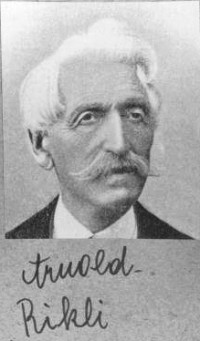Arnold Rikli
Arnold Rikli (born February 13, 1823 in Wangen an der Aare , Canton Bern , † April 30, 1906 in Sankt Thomas , Carinthia , Austria-Hungary ) was a Swiss natural healer. He is the founder of the "atmospheric cure", in which light and air baths play an essential role. Rikli was a supporter of the so-called life reform .
Life
Rikli was born the son of a respected politician and owner of a dye works . In view of his future tasks in his father's company, he received a strict upbringing. At the age of twenty he worked in his parents' dye works, where he had also completed his apprenticeship as a dyer. In 1845 he founded a yarn dyeing factory with his brothers Karl and Rudolf in Seebach Seeboden on Lake Millstatt (Carinthia). However, his main interest was already in naturopathy during these years, which was one of the reasons why his company ran into financial problems. During these years he constructed a bed steam apparatus and made a name for himself as a water doctor .
In 1854, after he had successfully cured himself of an illness, he moved with his family to the climatically favorable Veldes in Upper Carniola in what is now Slovenia to establish a sanatorium there. During the summer months he dealt - with some success, probably - mainly with lighter cases that he could choose himself, and gathered a considerable number of followers. In the winter months he treated first in Laibach , then in Trieste and Gries near Bozen, also more serious illnesses and sometimes failed, among other things, with his own children. Conflicts with doctors often ended in court, but Rikli confidently remained true to his theories until his death and was convinced that he had made an important contribution to medicine.
The Arnold Rikli Prize has been awarded annually by the Light Foundation in Atlanta (USA) since 1989. The award goes to work that deals with the biological effects of light on people. The Jörg Wolff Foundation has also been awarding an Arnold Rikli Prize, endowed with 10,000 euros, for photo-biological research in relation to the human organism since 2016. The award is under the patronage of the European Society for Photobiology (ESP).
Riklis healing cures
Rikli, who was also known as the “sun doctor”, treated his patients with water-air-light therapies, activity in the fresh air, intensive sunbathing ( heliotherapy ) and a vegetarian diet . His spa guests spent the nights in open huts, in the vicinity there were “air parks” such as the “Riklikum” or the “Arnoldshöhe”, fitness areas to a certain extent, where his patients wandered barefoot and minimally dressed. In the spa buildings, the guest bathed in pools and went under showers and steam baths, on the roofs there were spacious sun terraces. The main principle of the cure was the "alternating atmospheric stimulus" of water, air and light, which was supposed to restore the physical and mental balance.
Since Rikli did not believe the scientific knowledge of his time, he resisted conventional medical treatments such as vaccinations or operations and became a bitter opponent of the medical profession. The naturopaths, on the other hand, still emphasize his merits and contributions (including to light therapy).
Not least thanks to Rikli, Veldes became an important health resort and experienced a considerable boom in the years up to the First World War ; Even today, modified forms of Riklis cures are offered in today's Bled . One of his “students” was the painter and social reformer Karl Wilhelm Diefenbach (1851–1913), who founded a rural commune in Vienna based on the principles of Rikli. The industrialist's son Henri Oedenkoven , the pianist Ida Hofmann and the brothers Karl and Gusto Gräser , who together settled the vineyard above Ascona in the autumn of 1900 , also met in Rikli's sanatorium in Veldes . They called their company, to which a naturopathic institute belonged, "Mountain of Truth - Monte Verità ". This institution also followed the healing methods of Rikli, but also became a meeting place for cultural revolutionary spirits, the “cradle of alternative culture ”.
literature
- Alfred Brauchle : The dye works owner Arnold Rikli. The sun doctor. In: the same: history of naturopathy in life pictures . 2nd ext. Ed. By Große Naturärzte . Reclam-Verlag, Stuttgart 1951, pp. 204-218
- Zdenko Levental: The sun doctor Arnold Rikli. In: Gesnerus . Vol. 34 (1977), Vol. 3-4, pp. 394-403.
- Friedhelm Kirchfeld, Wade Boyle: Nature Doctors. Pioneers in Naturopathic Medicine. Medicina Biologica, Portland, Oregon; Buckeye Naturopathic Press, East Palestine, Ohio, 1994.
- Martin Green: Mountain of Truth. The counterculture begins. Ascona, 1900-1920. University Press of New England, Hanover and London, 1986.
- Robert Jütte : History of Alternative Medicine. From folk medicine to today's unconventional therapies. Verlag CH Beck, Munich 1996. ISBN 3-406-40495-2
- Harald Szeemann (Ed.): Monte Verità. Mountain of truth. Electa Editrice, Milano 1979.
- Kai Buchholz et al. (Ed.): The life reform. Drafts for the redesign of life and art around 1900. Volume 1. Häusser Verlag, Darmstadt 2001. ISBN 3-89552-077-2
- Eberhard Mros: Monte Verità phenomenon. Volume 1: The Settlers (1900–1920). Ascona 2007.
Web links
- Hubert Steinke : Rikli, Arnold. In: Historical Lexicon of Switzerland .
- History. The beginnings of tourism: Arnold Rikli (contribution from the city of Bled) (English)
- Arnold Rikli from Wangen, article by Zdenko Levental in the yearbook of Oberaargau 1977, pp. 133–44 (PDF file; 4.0 MB)
Individual evidence
| personal data | |
|---|---|
| SURNAME | Rikli, Arnold |
| BRIEF DESCRIPTION | Swiss natural doctor |
| DATE OF BIRTH | February 13, 1823 |
| PLACE OF BIRTH | Wangen an der Aare , Canton of Bern , Switzerland |
| DATE OF DEATH | April 30, 1906 |
| Place of death | Sankt Thomas , Carinthia , Austria-Hungary |
